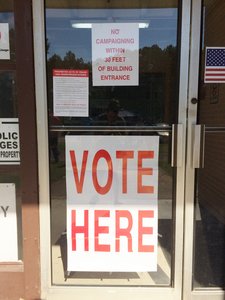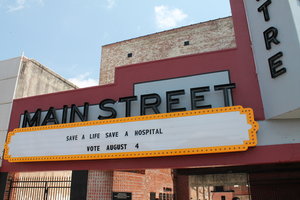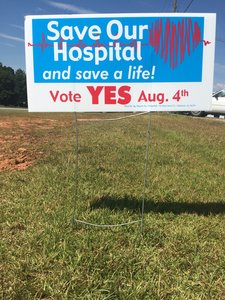An Insider's/Outsider's Reflection on the Randolph County Hospital Vote
Through my articles, I feel like I’ve been able to give a pretty good accounting of my summer here in Roanoke. I’ve talked about the highs (and there have been a lot of those), the lows, and the lessons I’ve learned about rural democracy and community engagement. The only thing that I really haven’t talked about has been arguably the most central issue of the summer—the community’s hospital vote.

On August 4, Randolph County came together to vote on whether to levy a one-percent sales tax to fund the creation of a new hospital in the county seat of Wedowee. In many ways, it felt like my summer here had been leading to that day.
For context, I should explain the healthcare situation in Randolph County. To my observation, the centers of care in the county are in Roanoke and Wedowee. Wedowee is the county seat but is a smaller community of about 800 people. Wedowee currently hosts the only hospital in the county and also maintains a health clinic; both are operated by Tanner Health Systems, a company out of Georgia. The Wedowee Hospital has served the county well for many years, but many seem to feel that the county is outgrowing its aging building. They point to longer wait times and overcrowding as reasons that community should look for new health solutions. The Tanner East Alabama Health Clinic was built in Wedowee in May 2013 and serves the county for its non-emergency, outpatient needs during normal business hours.
Roanoke is the larger of the two communities, with a population of around 6,500. It also has its own health facilities, with various private practices and a bustling non-emergency, outpatient clinic operated by Regional Medical Center out of Anniston. Roanoke once hosted the county hospital, staffed by full-time physicians and visiting physicians from larger neighboring cities like LaGrange and Opelika. The hospital closed in March 2011 due to financial strains, and the community has turned to various Randolph County health practices and to larger hospitals like Opelika’s East Alabama Medical Center. The county’s other two main communities, Wadley and Woodland, are smaller still, towns of 600 and 200, respectively. Both communities have their own clinics, but as with all communities in Randolph County, they have historically relied on larger regional hospitals like Tanner Medical Center in Carrollton or West Georgia Medical Center in Anniston for more-complex cases or specialized care.
The Plan
Since the vast majority of health facilities in the county only practice during business hours, in the past year there have been increased calls for a new health facility in the county that would ease the Wedowee Hospital’s burden and provide 24-hour emergency care. To achieve this aim, Tanner and the county brokered a deal in which the county would levy a 30-year, one-percent, widely applied sales tax to fund the building of a new hospital. For its part, Tanner agreed to operate the facility and provide the doctors, equipment, and expertise to run the new hospital for at least five years, with the possibility of extending their tenure in the county-provided building.
From its inception, the plan engendered considerable controversy, creating avid support and fervent opposition. From my understanding, the ‘yes’ campaigners argue that the county desperately needs a new health facility to support the community’s needs and that Tanner, an emerging provider with existing ties to the county, is the ideal administrator of this new hospital. They further argued that local lives that will be placed in jeopardy if emergency care is needed and patients are unable to reach the larger hospitals in time. They urged immediate action, with the idea that the longer the county waits to fix their healthcare facilities, the more lives will be placed at risk. They suggested that any hesitation might cause health care providers to be more reticent to come into their communities. From my understanding, while they agreed the community needed 24- hour emergency care, the ‘no’ campaigners protested that the contract between the county and the provider was weighted to benefit the provider. They said that the planned 15-bed hospital was too expensive and that the county would not be able to support a hospital of that scale. They urged the community to wait so that it could capitalize on emerging innovations in rural medicine. Some supported a counter-proposal that called for a part-clinic, part-ER, part three- or four-bed inpatient hospital that would focus on stabilizing local emergency cases before sending them on to bigger hospitals for more effective care.
Hot Summer Issue
It feels like all of my dealings this summer have been touched by the hospital issue somehow. For the majority of the summer, the marquee on the restored theater proclaimed a political message, urging Randolph County citizens to vote ‘yes’ for the hospital tax. During the ‘Summer on Main Festival’ on my first weekend in town, Tanner volunteers handed out refreshments and paper fans with the company’s logo. In my first week, at my first Economic Development Authority board meeting, the board convened to vote on whether it would officially endorse a ‘yes’ or ‘no’ position and to decide how it would publicize their stance. I attended a ‘no’ meeting in which alternate solutions were discussed and a Rotary club presentation by a Tanner executive on why Randolph County should vote yes. All summer, ‘yes’ signs have been a part of my view of the county landscape, dotting the sides of the road on the county’s major thoroughfares and staking homeowners’ positions in many front lawns.

As an outsider, I feel like I was able to get an interesting perspective view on the issue. Since my host and my community contacts were on opposing sides of the issue, coupled with the broader discussions in town, I feel I was able to get a fairly complete picture of both stances. I was able to take in these views, do my own research, and come to my own conclusions about my personal position on the hospital vote.
In some ways, local political issues in smaller communities can seem even stickier than those in large cities. Of the community members I interacted with, it seemed nearly impossible to stay neutral or to hide your position. Everyone knew where everyone else stood, almost as if polling was playing out in real-time throughout the summer. Interestingly, it seemed as if most of the actual debate played out in print rather than face-to-face. I heard whispered conversations about ‘the other side’ in the back of civic meetings and church services but very little actual conversation between the two groups. In fact, the primary mode of public discussion seemed to be through the ‘Letters to the Editor’ section in the local paper, The Randolph Leader.
The Leader is published every Wednesday morning, and this summer it became part of my weekly ritual to sit down and read the paper before I started my day. The first thing I would do when I got my copy on Wednesday morning would be to flip to seventh page of the first section— the letters to the editor. In this section, citizens of Randolph County from both sides of the debate gave voice to their concerns, almost as if it was easier to commit their opinions to paper than to say them out loud. As with any controversial issue, emotions ran high. It seemed to me that some genuinely used the paper as a platform to advocate for their position, but others used it as a position from which to launch attacks at their opponents. Perhaps feeling the paper gave them an outlet to say things they couldn’t or wouldn’t to their neighbors on the other side of the ideological divide, there were snide remarks and unkind words exchanged. As the summer progressed and the vote grew closer, the letters grew more strident in their criticism of their opponents and more fervent in their support of their own side. In the final newspaper published before the vote on August 4th, there were four full pages of letters to the editor. Some were kind and informative, others were not.
Moving Toward the Big Vote
As the vote approached, I also sensed a secondary current, less overt but very much present. In confidential asides, campaigners from both sides confessed to being fatigued at the whole process. They were ready for the vote ‘to just be over already,’ and for the county to return to business as normal where the largest disagreements were over high school football rivalries. I understood their sentiments, and in many ways I shared them. If I came to Roanoke or Randolph County during any other summer, I feel like I probably would have gotten a much different view of the community. But, if given the choice, would I choose to be a Living Democracy Fellow during a ‘normal’ summer over one characterized by a hot-button issue? I don’t think I would. By coming to the county during a summer of serious contention, I feel like I was able to gain a very unique perspective on community engagement and local politics. During this summer, I’ve come to understand that the citizens of Roanoke and Randolph County care deeply about the future of their community. Though at times I think that their opinions could have been discussed with more civility and forthrightness, I believe that each side fought as hard as they did because they genuinely believed that their position would be in the county’s best interest. In many ways, I think the passion that both sides showed was remarkable, admirable even. In an age in which citizens are arguably less civically engaged than they have ever been, there was something heartening about the fact that the majority of the county was engulfed in the issue and that debates over a single civic issue characterized the entire summer.
At long last, August 4 arrived, and Randolph County came out to vote. My host was among the delegation selected for polling duty. When visiting her in the afternoon, she said that the polling station had seen an excellent turnout and that whichever way the vote went, they knew it would really reflect the views of the county. From my perspective, it felt like very little work was done that day as the county waited with bated breath to hear the vote’s outcome. Finally, at close to 9 p.m., the results came in. My host and I gathered round her portable radio in the kitchen, adjusting the antenna to make sure we received the signal. When the transmission came through, we learned that the ‘yes’ vote had won handily, carrying the county with something like 85 percent support. My host was overjoyed. I was happy for her and her excitement, though my thoughts were also with my friends in the community who would be greatly disappointed.
Lessons Learned
In the days immediately after, I was surprised at the calm after the storm. There were no victorious banners or smug “I-told-you-so”s. It was almost as if the community had agreed to an unspoken temporary détente. Little by little, the ‘yes’ signs, such a fixture of my summer here, silently began disappearing from yards and roadways. Perhaps it’s that they realize there is still a long road ahead before the hospital comes to fruition— after all, the county commission still needs to create a motion to designate the tax funds toward the hospital project, to float a bond to help finance the project, and to actually construct the facility. Or perhaps, they too are ready to return to normal.
I’ve observed and learned a lot this summer, more than I ever could have anticipated at the outset. I’ve learned many things about rural engagement, civic responsibility, and effective citizenship. I think one of the most important things I’ve learned, however, is the importance of civil civic conversations and deliberative discussions in the democratic process. I think that it’s through these discussions that communities are better able to work through contentious issues and come to understand differing points of view. I think that these conversations are a vital step in addressing differing concerns within a community and bringing about meaningful change.
As someone very wise has been reminding me all summer, ‘the thing that people need to remember is that when all this is said and done, we still have to live with each other.’ When all the smoke cleared after the final vote, I think citizens of Randolph County realized this truth. After weeks of contention over the hospital vote, I have seen the citizens come back together and function as a community, without gloating from the ‘yes’ side or bitterness from the ‘no’ side.

On August 4, the citizens of Randolph County came together and made their voices heard, voting for the construction of a new hospital. And although improved healthcare is always beneficial to a community, I think the civic linkages established over this issue are equally vital. Concerned citizens campaigned passionately for their respective sides, growing involved to an extent they may not have otherwise. I hope that this level of involvement sets a precedent for further civic issues in the county and can be a model to other rural counties that would like to increase citizen participation in civic initiatives.
I think that we have a lot to learn from Randolph County. I know that personally I have been inspired by their warmth, passion, and willingness to seek creative solutions for community concerns. As evidenced by the vote, the community believes the creation of a hospital will be one of these solutions, easing the county’s emergency health crisis and propelling the county forward. I genuinely hope for the best for this new hospital, that it will benefit the community that graciously adopted me for the summer. But I know that no matter the outcome, Roanoke and Randolph County will continue to grow and thrive. If I’ve learned anything this summer, it’s that Roanoke and Randolph County will carry on in the face of community challenges and work tirelessly toward a brighter future.
Tags: Roanoke